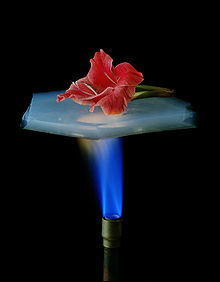Also termed as Frozen Smoke
It is so light that 1 ounce of new ‘frozen smoke’ can carpet 3 football fields!
Gonna replace a lot of conventional materials.
Excellent properties as Insulator, packaging, conductor, heat resistant ,
extremely light weight etc.

Silica aerogel is the most common type of aerogel and the most extensively studied and used.
# Commercially, aerogels have been used in granular form to add insulation to skylights.
# Transparent silica aerogel would be very suitable as a thermal insulation material for windows, significantly limiting thermal losses of buildings.
# Its high surface area leads to many applications, such as a chemical adsorber for cleaning up spills (see adsorption). This feature also gives it great potential as a catalyst or a catalyst carrier.
# Aerogel particles are also used as thickening agents in some paints and cosmetics.
# Aerogels are being tested for use in targets for the National Ignition Facility.
# Aerogel performance may be augmented for a specific application by the addition of dopants, reinforcing structures, and hybridizing compounds. Using this approach, the breadth of applications for the material class may be greatly increased.
# Commercial manufacture of aerogel 'blankets' began around the year 2000. An aerogel blanket is a composite of silica aerogel and fibrous reinforcement that turns the brittle aerogel into a durable, flexible material. The mechanical and thermal properties of the product may be varied based upon the choice of reinforcing fibers, the aerogel matrix, and opacification additives included in the composite.
# The US Navy is evaluating aerogel undergarments as passive thermal protection for divers.[14]
# Aerogels are also used in particle physics as radiators in Cherenkov effect detectors.

.
It is so light that 1 ounce of new ‘frozen smoke’ can carpet 3 football fields!
Gonna replace a lot of conventional materials.
Excellent properties as Insulator, packaging, conductor, heat resistant ,
extremely light weight etc.

Silica aerogel is the most common type of aerogel and the most extensively studied and used.
# Commercially, aerogels have been used in granular form to add insulation to skylights.
# Transparent silica aerogel would be very suitable as a thermal insulation material for windows, significantly limiting thermal losses of buildings.
# Its high surface area leads to many applications, such as a chemical adsorber for cleaning up spills (see adsorption). This feature also gives it great potential as a catalyst or a catalyst carrier.
# Aerogel particles are also used as thickening agents in some paints and cosmetics.
# Aerogels are being tested for use in targets for the National Ignition Facility.
# Aerogel performance may be augmented for a specific application by the addition of dopants, reinforcing structures, and hybridizing compounds. Using this approach, the breadth of applications for the material class may be greatly increased.
# Commercial manufacture of aerogel 'blankets' began around the year 2000. An aerogel blanket is a composite of silica aerogel and fibrous reinforcement that turns the brittle aerogel into a durable, flexible material. The mechanical and thermal properties of the product may be varied based upon the choice of reinforcing fibers, the aerogel matrix, and opacification additives included in the composite.
# The US Navy is evaluating aerogel undergarments as passive thermal protection for divers.[14]
# Aerogels are also used in particle physics as radiators in Cherenkov effect detectors.

.
